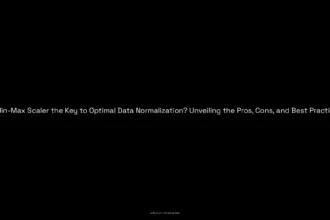Are you tired of the limitations of traditional regression analysis? Want to take your predictive modeling to the next level? Look no further! In this blog post, we will dive into the fascinating world of multioutput regression. Whether you’re a data scientist, a researcher, or just someone who loves uncovering hidden patterns in data, multioutput regression is a powerful tool that can help you unlock new insights and make more accurate predictions. So, get ready to explore the ins and outs of this versatile technique and discover how it can revolutionize your data analysis game.
Table of Contents
ToggleUnderstanding Multioutput Regression
Picture yourself as a meteorologist, tasked with forecasting not just the temperature, but also the humidity and wind speed for the next day. This is where the power of multioutput regression shines, as it allows you to unravel the intricate dance between different weather variables. In the realm of machine learning, this is analogous to predicting multiple numerical variables simultaneously, a task that standard regression models, with their single-value prediction, cannot perform. Thus, specialized algorithms are brought onto the stage, designed to handle the complexity of multiple outputs with grace.
Let’s delve into the specifics with a table summarizing key facts:
| Term | Definition |
|---|---|
| Multioutput Regression | Predicting several numerical variables from given inputs, using specialized algorithms. |
| Example | Predicting coordinates, like x and y values, from an input example. |
| Linear Regression with Multiple Outputs | A variant known as multivariate linear regression, predicting multiple dependent variables from independent ones. |
| Multioutput Classification | A machine learning approach that yields multiple outputs for each prediction, as opposed to a single output in typical classification. |
Consider an engineer designing a bridge; they must calculate the load, tension, and compression in various sections. Multioutput regression algorithms act like a master engineer, predicting all these elements in a single, sophisticated analysis. This is not just about efficiency; it’s about the intricate interplay of multiple factors that define the real world.
One might wonder, “Can linear regression embrace this multiplicity?” Indeed, it can. Known as multivariate linear regression, this extended family member of regression analysis brings multiple dependent variables into the limelight, offering a symphony of predictions based on a set of independent variables.
Do not confuse multioutput regression with multioutput classification. While they share the trait of predicting multiple outputs, classification deals with categorical data, assigning each input to two or more classes, thereby painting a picture with broader strokes of categorical colors.
As we weave through the fabric of multioutput regression, we uncover patterns that standard regression cannot see, predicting not just one, but a constellation of connected outcomes that mirror the complex nature of reality. This predictive prowess propels us into a future where our insights are not just singular, but multidimensional.
In the following sections, we shall explore the different types of multioutput models and their applications, providing a deeper understanding of how these advanced algorithms can be harnessed for complex predictive tasks.
Multioutput Classification
Within the intricate tapestry of machine learning, multioutput classification emerges as a nuanced thread, distinct and complex. Picture a scenario where decision-making extends beyond the monochromatic choice of ‘yes’ or ‘no’. Imagine the nuanced task of sorting a vibrant mosaic of clothing articles, each demanding recognition for not just its type—be it a shirt, skirt, or sweater—but also clamoring for its color to be identified. This is where multioutput classification, a method adept at discerning multiple categorical labels, becomes indispensable.
Multioutput classification stands apart from its machine learning counterparts in its ability to deftly handle scenarios where the output is not a single data point but a constellation of categories. It’s like a skilled juggler keeping two balls in the air where traditional classifiers would manage only one. It confronts the challenge of dual categorization, such as when an article of clothing must be classified by both type and color, performing what could be seen as a choreographed dance of data analysis to arrive at a multifaceted conclusion.
Consider the practical application in an e-commerce setting where the vast inventory of products must be meticulously categorized to enhance user experience and streamline search functionality. Here, a multioutput classifier would work behind the scenes, simultaneously assigning each product to its appropriate apparel category and pinpointing its color spectrum. This dual-classification capability is not just efficient; it’s transformative for industries that thrive on precise, multidimensional categorization.
At its core, multioutput classification is about embracing complexity and delivering precision. As we delve further into the world of predictive modeling, we see that its sibling, multioutput regression, shares a similar ethos but dances to a different tune—one that harmonizes numerical predictions. In the following sections, we will untangle the threads of these sophisticated predictive models, exploring their applications and the benefits they bring to the table.
Multiple Linear Regression
In the realm of statistics and machine learning, multiple linear regression (MLR) emerges as a pivotal tool, akin to a mathematical maestro that orchestrates a symphony of variables to predict nuanced outcomes. This sophisticated variant of linear regression extends the traditional model by incorporating not just one, but several dependent variables—also heralded as response variables—into its predictive embrace.
Imagine you are a meteorologist, tasked with forecasting not just the likelihood of precipitation, but also the temperature and wind speed for the day. MLR is much like your forecasting model, adept at taking a multitude of independent variables—the predictors such as humidity, barometric pressure, and historical weather patterns—and unveiling their intricate dance with multiple dependent variables. Through MLR, one can ascertain how these variables collectively influence the forecasted weather conditions.
Let’s delve into a tangible example that illustrates the prowess of MLR. Picture a real estate scenario where the value of a property is not solely determined by its square footage, but also by a myriad of other features such as the number of bedrooms, proximity to amenities, and the year of construction. In this case, MLR helps in predicting the property’s price (the dependent variable) by analyzing how it is affected by all these different features (independent variables).
In the context of multioutput regression, MLR stands as a cornerstone technique. It enables the prediction of multiple outcomes simultaneously, offering a more comprehensive understanding of the relationships between variables. Whether it’s forecasting various financial metrics for a business, estimating multiple health indicators from medical data, or predicting coordinates in spatial analyses, MLR is the statistical workhorse that powers these complex predictions.
At its core, MLR functions by fitting a linear equation to the observed data. The equation represents a hyperplane in the multidimensional space of the independent variables that best approximates the dependent variables. The coefficients of this linear equation encapsulate the sensitivity of the response variables to changes in the predictors, providing invaluable insights into the dynamics of the system being studied.
By leveraging MLR, analysts and researchers can unearth patterns that might be imperceptible with simpler models. It allows for a nuanced understanding of how multiple factors come together to shape an outcome, making it an indispensable tool in fields as diverse as economics, psychology, climatology, and beyond.
It is important to note, however, that for MLR to be effective, certain assumptions must be met. These include linearity, independence, homoscedasticity, and normality of the residuals. When these assumptions are violated, the model’s ability to provide reliable predictions can be significantly compromised. Consequently, careful diagnostics and potentially the use of alternative methods or data transformations may be required to ensure the robustness of the MLR model.
In summary, MLR is not just a statistical method; it is a gateway to a more profound comprehension of the complex interplay among variables that define our world. As we prepare to delve into the benefits of multioutput regression in the following section, it is clear that MLR is more than just a tool—it is a lens through which we can view the multitude of threads that weave the fabric of our data-driven narratives.
Benefits of Multioutput Regression
In the intricate dance of data analysis, multioutput regression emerges as a pivotal partner, enabling a harmonious understanding of complex relationships within datasets. Imagine a skilled conductor, adept at guiding an orchestra’s many instruments to produce a symphony in perfect unison. Similarly, multioutput regression orchestrates the interplay between multiple predictor variables and their corresponding outcomes, crafting a cohesive narrative from what could otherwise be an overwhelming cacophony of information.
At the heart of this methodology lies its capacity to simultaneously predict multiple target variables. This is not just an exercise in statistical acrobatics but a practical solution to multidimensional questions. Consider a real estate developer seeking to forecast both the potential rental income and maintenance costs of a property. Multioutput regression steps in as an analytical ally, enabling predictions that encapsulate a more complete financial picture, thereby improving investment decision-making.
Furthermore, this approach shines a spotlight on the often-overlooked interdependencies between target variables. By capturing these subtle connections, the model provides insights that extend beyond the surface, revealing the undercurrents that drive the system’s behavior. For instance, in healthcare, understanding how different symptoms or conditions may influence one another can lead to more holistic patient care and improved treatment plans.
Decision-makers across industries stand to benefit from the enhanced accuracy and reliability of predictions made possible by multioutput regression. In an era where data-driven strategies reign supreme, the ability to integrate and interpret multiple outcomes simultaneously is not just a competitive advantage—it is an imperative for those who wish to navigate the complexities of modern datasets with precision and foresight.
As we delve further into the intricacies of multiple regression, let us carry forward the understanding that its true power lies not just in the prediction of discrete outcomes, but in the holistic view it provides of the systems we seek to understand and influence.
Varieties of Multiple Regression
Just as an artist selects from a palette of colors to create a nuanced masterpiece, statisticians and data analysts choose from a variety of multiple regression techniques to illuminate the hidden patterns within datasets. In the realm of data, these patterns translate into insights that drive strategic decisions and foster understanding. Let’s explore the tapestry of methods that make up multiple regression analyses.
Standard Regression
Standard regression, the cornerstone of predictive analytics, paints the baseline from which complex relationships are measured. In this method, a dependent variable—the outcome we seek to understand or predict—is modeled as a function of one or more independent variables. Think of it as the process of plotting a course through a multidimensional space, where each independent variable adds a dimension, and the dependent variable represents the destination.
Within this standard approach, the integrity of the model is paramount. Each coefficient attached to an independent variable in a standard regression equation tells a story of influence, of how much a single unit change in that variable is expected to impact the dependent variable, holding all other factors constant.
Stepwise Regression
When the path to understanding becomes tangled with numerous potential predictors, stepwise regression steps in as the discerning sculptor. As a more refined approach, stepwise regression uses statistical algorithms to select which variables enter or exit the model based on specific criteria, such as the p-value from a t-test or an F-test. It’s akin to a strategic game of chess where each move—adding or subtracting a predictor—is calculated to optimize the model’s performance.
Stepwise methods come in two main flavors: forward selection, where variables are progressively added to the model, and backward elimination, where the model starts with all candidate variables and systematically removes the least significant ones. The result is a model that aims to balance simplicity with predictive power, stripping away the extraneous to reveal the core drivers of the dependent variable.
Yet, the elegance of stepwise regression comes with a caveat. The automated process may introduce bias or overlook important interactions between variables. It requires a careful hand and a critical eye to ensure that the model it produces is not just statistically significant, but also meaningful and interpretable in the real world.
These two forms of regression—standard and stepwise—are but a glimpse into the intricate world of multiple regression analyses. Each serves a distinct purpose and offers a unique lens through which to decipher the complex web of variables that characterize our data-rich surroundings. As we continue to explore the main types of regression in the following sections, keep in mind the power these tools wield in transforming raw data into actionable intelligence.
Our journey through the landscape of multiple regression has only just begun, and as we delve deeper, we’ll uncover more methods, each with its own story to tell and contribution to the art of data analysis.
Main Types of Regression
In the realm of data analysis and machine learning, regression is akin to a compass guiding us through the labyrinth of numbers, pointing us towards patterns and associations. Like a master key unlocking different doors, each regression technique opens up new possibilities for understanding and predicting outcomes. At the heart of this exploration are two fundamental types of regression that form the cornerstone of predictive analytics: simple linear regression and multiple linear regression.
Imagine you are standing before a vast canvas, with simple linear regression being the solitary brushstroke that draws a direct line between a single cause and its effect. This type of regression predicts a dependent variable based solely on the value of one independent variable. It’s the first step in uncovering the narrative behind the data, a story of how one factor can sway an outcome.
As our understanding deepens, the canvas grows more complex, and we turn to multiple linear regression. Here, the plot thickens, and multiple brushstrokes converge to form a more detailed image. Predicting a dependent variable now relies on the interplay of two or more independent variables. It’s like listening to a symphony—each instrument adds depth to the melody, creating a richer, more nuanced composition.
The beauty of these regression types lies in their adaptability. Whether we’re forecasting sales based on advertising spend and market trends, or estimating housing prices from square footage, location, and age, these models help us weave disparate threads into a coherent predictive fabric.
While simple linear regression offers a straightforward, focused lens, multiple linear regression provides a multi-faceted perspective. Each independent variable is like a new character in our unfolding story, adding layers and dimensions. This complexity allows us to capture more of the nuances in our data, delivering insights that a single-variable analysis might miss.
As we delve deeper into the world of multioutput regression, we find that the narrative structure of our data can be even more intricate, with multiple dependent variables interwoven like subplots in a novel. Here, our regression models must not only predict one outcome but must juggle several at once, each with its own set of influencing factors.
The journey through regression is one of constant discovery, and as we move from the simplicity of a single variable to the richness of multiple variables, the story of our data becomes ever more compelling. The next chapter in our saga will take us to the conclusion, where all the threads come together to reveal the bigger picture.
Conclusion
The realm of machine learning revels in its ability to unravel complexity, turning the chaotic interplay of variables into harmonious symphonies of insight. At the heart of this domain, multioutput regression and classification stand as towering beacons of innovation, guiding us through the intricacies of datasets that are as multifaceted as they are informative. These advanced analytical tools do not merely predict outcomes; they weave a tapestry of predictions that capture the vibrant patterns of variability across multiple dimensions.
Imagine the art of prediction as a masterful orchestra, where each instrument represents a variable within our dataset. In simple or multiple linear regression, we may hear a solo or a collective harmony that predicts a singular outcome with grace. However, with multioutput regression, the orchestra expands, and we are privy to a richer performance that predicts not one, but a chorus of outcomes that resonate together, each influenced by the interlaced threads of our independent variables.
With every step forward in the evolution of these techniques, our predictive models grow increasingly sophisticated, the accuracy sharpening like a lens bringing the future into focus. As practitioners and enthusiasts of this analytical art, we remain on the cusp of discovery, eagerly anticipating the next breakthrough that will further elevate the power and precision of multioutput modeling.
In the vast ocean of data, let us sail with confidence, knowing that the sails of our ships—the algorithms of multioutput regression and classification—are robust and capable. They catch the winds of data, propelling us forward to explore uncharted territories of knowledge and application. The journey is ongoing, the horizon endless, and the potential for insight as boundless as the data itself.
As we close this section, remember that the tapestry of multioutput regression is ever-expanding. With each thread we weave, the picture becomes clearer, and our understanding of the world around us deepens. The future beckons with promises of greater discoveries, and together, we advance towards it, guided by the light of our collective curiosity and the tools of our trade.
Q: What is multioutput regression?
A: Multioutput regression involves predicting two or more numerical variables using specialized machine learning algorithms that support outputting multiple variables for each prediction.
Q: Can you provide an example of multioutput regression?
A: An example of multioutput regression is predicting a coordinate, such as predicting both x and y values given an input.
Q: What are the advantages of multioutput regression?
A: Multioutput regression methods allow for effective modeling of multi-output datasets by considering the relationships between features, targets, and the relationships between the targets. This guarantees a better representation of the data.
Q: Can linear regression have multiple outputs?
A: Yes, multiple output linear regression, also known as multivariate linear regression, exists. In this regression model, multiple dependent variables (response variables) are predicted based on a set of independent variables (predictors).





